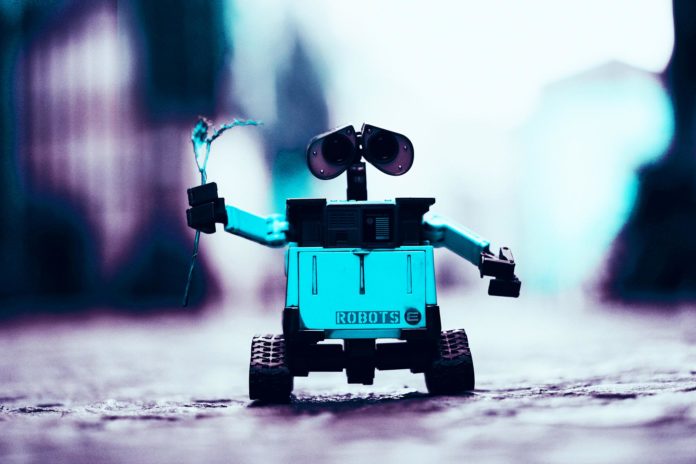
How would you feel if your boss tapped you on the shoulder and said, in a deadpan voice, “Please gather your things and leave. Your job will now be performed by a model XQJ-37 Robo-Beeper.” You might say, “Beep you.” But it wouldn’t get you very far (and might result in a call for a security escort) because jobs by the millions are falling away to machines that can think faster, move more efficiently, and don’t complain or join a union when they’re asked to work overtime.
It’s a Good Time to be Creative
Industrial robots have been deployed to the factory floor as far back as the 1950s, and the automotive industry has made the best use of robots, with a 38% market share of industrial robots, as of 2015. But the recent explosion in robotic technology has put a far wider variety of jobs at risk. By the year 2020, about half of all U.S. jobs are in danger of being replaced by robots, according to a 2013 study performed by Oxford University.
The Oxford study identified over 700 at-risk jobs, along with the probability that a mechanical man or woman would be doing them in the near future. Asking the question, “Can the tasks of this job be sufficiently specified,” the researchers were able to assign ranks to jobs, based on how automatable they are. For instance, the jobs at the top of the list — telemarketers, library technicians, and tax preparers – were deemed nearly fully-automatable, while recreational therapists, emergency management directors, and supervisors of mechanics were considered the occupations least likely to get a silicon makeover.
Some of the results seem counterintuitive. Sales occupations, for example, are associated with a high degree of social interaction, and it seems difficult to believe that a robot would take many of these jobs. But being a cashier, telemarketer or rental clerk doesn’t require a high degree of social intelligence, putting these occupations at high risk for replacement by an automated device. On the other hand, jobs in the science and engineering fields may look like easy pickings for a robotic mind, yet the creative intelligence demanded by mathematicians and engineers remains out of reach of computerized machines — for now.
Creative and social intelligence represent bottlenecks to computerization that cannot be overcome at this point in robotic development. Similarly, six of the nine factors the researchers examined — fine arts, originality, negotiation, persuasion, social perceptiveness, and assisting and caring for others, offered any job associated with them a low risk of automation. The other factors, manual dexterity, finger dexterity, and cramped work space, ranked high. While most healthcare jobs are safe, few assemblers or machine operators will be spared the pink slip, if the Oxford researchers’ predictions come true.
Did I Sleep Through a Couple of Revolutions?
The World Economic Forum (WEF) entered a report in early 2016 describing a “Fourth Industrial Revolution” upon which the world is about to embark, driven by, among other things, nanotechnology, artificial intelligence, and robotics. This data goes beyond merely predicting which jobs are at risk, and makes the bold conjecture that over 5 million jobs are going away over the next five years.
371 individual companies responded to the survey conducted by the researchers in 2015, which included more than 13 million employees in 15 major developed and emerging economies. The report predicts further erosion of Manufacturing and Production work, as might be expected. Assembly and factory workers, along with chemical processing plant operators, will find steep declines in job opportunities. Growth is predicted in the computer and mathematical fields, however, along with architectural and engineering posts. STEM positions will remain in demand for the time being.
A full two-thirds of the net 5.1 million job-loss will impact those in the Administrative and Office job families; routine white-collar workers will be decimated. With the advent of the Internet of Things, cloud technology, mobile internet, and Big Data analytics, it simply isn’t efficient to maintain a large workforce in these roles, according to the report.
Maybe It’s Not All Bad. Right?
A quick compare/contrast of the Oxford study and the WEF report reveals an important observation: just because a job can be automated, doesn’t mean it necessarily will be. Managers will need to assess which positions make sense to automate and which ones wouldn’t result in a reasonable Return On Investment. From a financial point of view, a human wage-earner might be the best solution, given the complexity of a particular task, combined with the costs of maintaining and upgrading robotic equipment. Supply-and-demand can’t be ruled out, since a large, available pool of workers may make automation economically unfeasible. And not every professional robot would be easily accepted by clientele; for example, the HOSPI-R drug delivery robot can assume some nurse duties, but any human contact beyond its current capabilities might prove distasteful to most patients.
Besides the Healthcare industry, another relatively safe zone is Education. Even though, according to the Oxford study, improved user interfaces and machine learning will help automate this area, a skills revolution will produce such a great demand for education that it will, according to the World Economic Forum report, “become a noteworthy new source of employment itself.”
I Feel the Need… The Need For Read. Ing.
Education and developing a skilled workforce is going to be essential to a successful, new machine revolution. The Oxford study states that “The reason why human labor has prevailed relates to its ability to adopt and acquire new skills by means of education.” In other words, human labor is in a race with robot labor, in the sense that technology may outpace the ability of the educational system to provide a skilled workforce. If society is wise, it will heed the studies and the data to create education policies that counterbalance the risk of job loss.
A scene in the award-winning 2016 film, Hidden Figures, provides a historic example of our modern situation. Faced with the prospect of losing her job-crunching job to a mainframe IBM computer, Dorothy Vaughan spends her bus rides learning the computer language FORTRAN, affording her the ability to program the new-fangled thing and keep working. The currently available workforce will need to be re-trained now — we just can’t wait for a better-equipped generation to come along. Corporations need to take an active role in availing their workforce of advanced educational opportunities, and like Dorothy, individuals need to be proactive in their continuing training.
A Gap in the Plan
The critical need to upskill the workforce is far from the only worry. It’s anticipated by the WEF report that our coming technological revolution will widen the existing regional and gender wage gaps. In terms of gender, the WEF report indicates that STEM industries are on the rise, which employs far fewer women than men. Even if more women are in the professional workforce overall, STEM-related jobs tend to pay higher salaries, resulting in a larger wage-parity between women and men in the future.
The WEF report further reveals the potential for a widening gap between the economies of wealthy and poor nations. Regions with high unemployment, such as the Middle East and Africa, are failing to equip their young people with the skills necessary to compete in a world driven by computers, A.I., and robotics.
Rise of the Humans
Market forces almost always prevail. A highly technological future is coming and appears unstoppable, but we will either rise to meet the demands of a robotic workforce, or the economy will falter and make an inevitable correction. Staying one step ahead of the androids is our best hope.
Advertisement
Learn more about robots on MysticSauce.com

















